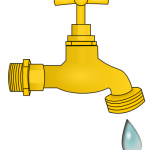Conserving Water & Saving Money, they Go Hand in Hand!
It’s just a few drips, right? Wrong! Even small leaks will increase your water/sewer bill and waste water!
Identifying and fixing leaks will save water and reduce your water/sewer bill.
Common household leaks are:
- Dripping faucets, at the rate of 1 drip per second, it can waste up to 250 gallons a month.
- A shower leaking at 10 drips per minute wastes up to 50 gallons per month.
- The average leaky toilet can waste about 200 gallons of water per day. That can amount to over 6,000 gallons a month for just one leaking toilet! An improperly adjusted or broken fill (ballcock) valve is the most common toilet leak.
- Irrigation system leaks and overwatering are a common source of wasted water.
- Estimates are that one in 20 pools has a water leak severe enough to be detectable by daily water level checks.
- Power washing homes and driveways uses a lot of water.
- Hand washing vehicles can use more water than running it through a car wash, reason being, car washes recycle water.
- The average household’s leaks can account for nearly 10,000 gallons of water wasted every year.
- 10% percent of homes have leaks that waste 90 gallons or more per day.
What Can I Do if My water/sewer bill is unusually high?
Monitoring and understanding your water usage is the best thing you can do to reduce your water usage and in the process, reduce your water/sewer bill. The following websites, especially the next 3, will help you achieve that!
Check your water/sewer bill month to month usage to see if your usage has increased more than usual. https://www.h2oinnovation.com/district-payment
Monitor your water usage on EyeonWater. You can check your usage by the day and by the hour. Doing so can help you pinpoint times of high usage. Using that info you can figure out what is the source. You can also set up an alert that will let you know when your water usage is higher than normal. https://eyeonwater.com/signin. Need help with the EyeonWater website? Contact the H20 Innovation Call Center or send a message via the Contact tab on this site.
Use the Texas A & M WaterMyYard website to help you manage your irrigation system. https://watermyyard.org
The NHCRWA website contains a very good conservation section designed to help you reduce your usage. https://wateru.nhcrwa.com/courses/conservation
The Harris-Galveston County Subsidence District is another good source of conservation information. https://hgsubsidence.org
The United States Environmental Protection Agency website is also a good source for conservation materials. https://www.epa.gov/watersense
Remember seeing all those water conservation inserts in your 2021 monthly water/sewer bill? They are an excellent source of water savings tips. Below are four examples, you can view them all at https://www.nhcrwa.com/docs/billing-insert-order-form.
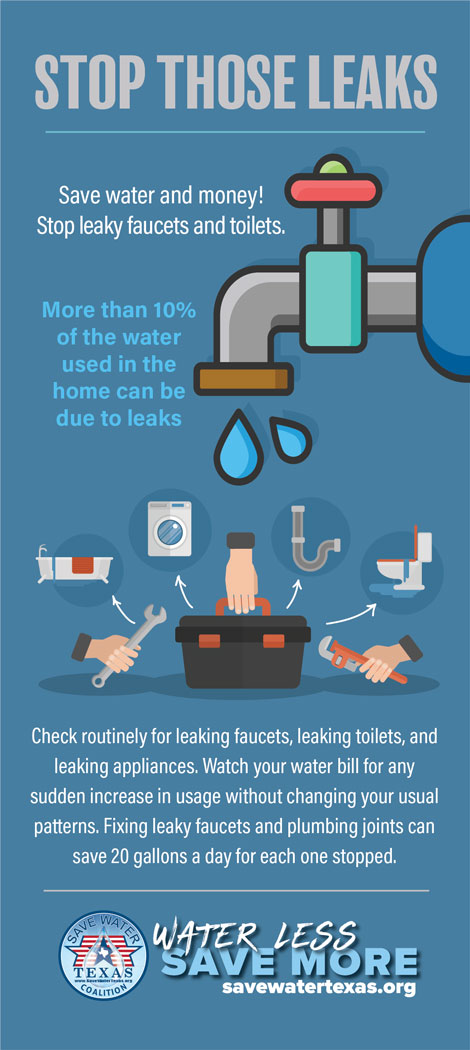
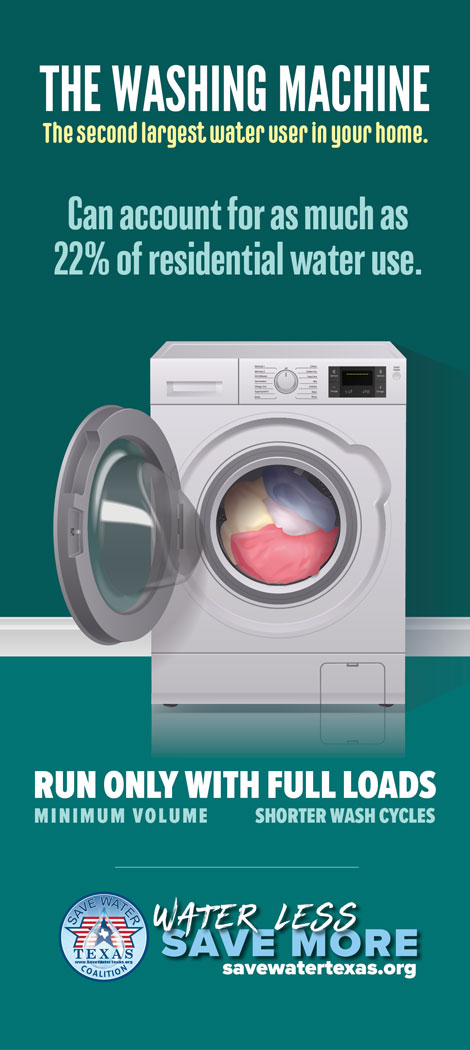
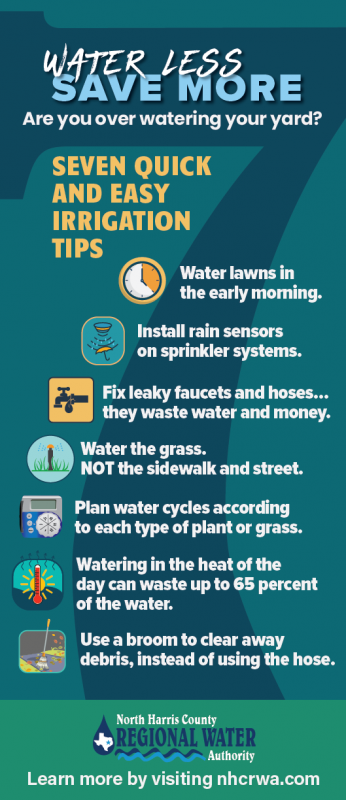
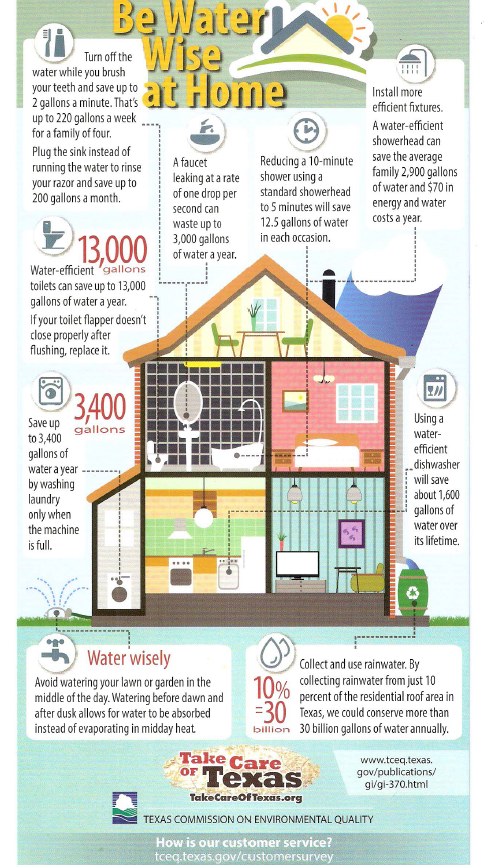
And more water conservation tips:
- Use native plants and shrubs whenever possible in landscaping your yard. They generally require watering less frequently, and are often low-maintenance, too.
- Water grass separately from flower beds and landscaped areas, using sprinklers that broadcast large drops for grass and soaker hoses or drip irrigation systems for trees, shrubs and flower beds.
- During the Summer months in the Houston area, don’t water more than what is necessary to maintain a healthy lawn. Applying .75 to 1 inch of water (subtracting any rainfall) every five days is recommended.
- Water during early morning or evening hours when evaporation losses will be less than during the heat of the day.
- Don’t cut the grass too short. Longer blades help reduce evaporation and shade the soil.
- Backwash pool filters only when necessary. If a timer controls the backwash, check and adjust the frequency of the cycle to ensure optimal efficiency.
- Check the pool regularly for cracks and leaks and make repairs promptly. If the water level drops more than an inch in one day, investigate for problems.
- Use a pool vacuum that recycles the water when cleaning the pool.
- Check water line connections and faucets for leaks and repair immediately.
- Make sure that the line from the water meter to your house is free of leaks. To check, turn off all indoor and outdoor faucets and water-using appliances.
- When remodeling a bathroom, install a new low-volume flush toilet that uses only 1.6 gallons per flush.
- Test toilets for leaks. Add a few drops of food coloring to the water in the toilet tank, but do not flush the toilet. Watch to see if the coloring appears in the bowl within a few minutes. If it does, the toilet has a silent leak that needs to be repaired.
- Stop running the water while you brush your teeth, for example, just to rinse the toothbrush. The same method can be used for shaving and for washing hands.
- Consider installing a low-flow faucet aerator. This could actually help you save up to half the water you normally use at the sink.
- Insulate all hot water pipes to reduce the delays (and wasted water) experienced while waiting for the water to heat up.
- Install a low-flow showerhead to limit the amount of water to less than three gallons per minute.
- When purchasing new appliances, check the water requirements of various models and brands. Some use less water than others.
- Only run the dishwasher with a full load. This saves water, energy, detergent and money.
- Keep a container of drinking water in the refrigerator. Running water from the tap until it is cool enough to drink is wasteful.
- Wash only full loads of clothes when using your washing machine.
- Use cold water whenever possible. This saves energy, too, and conserves the hot water for other use.

